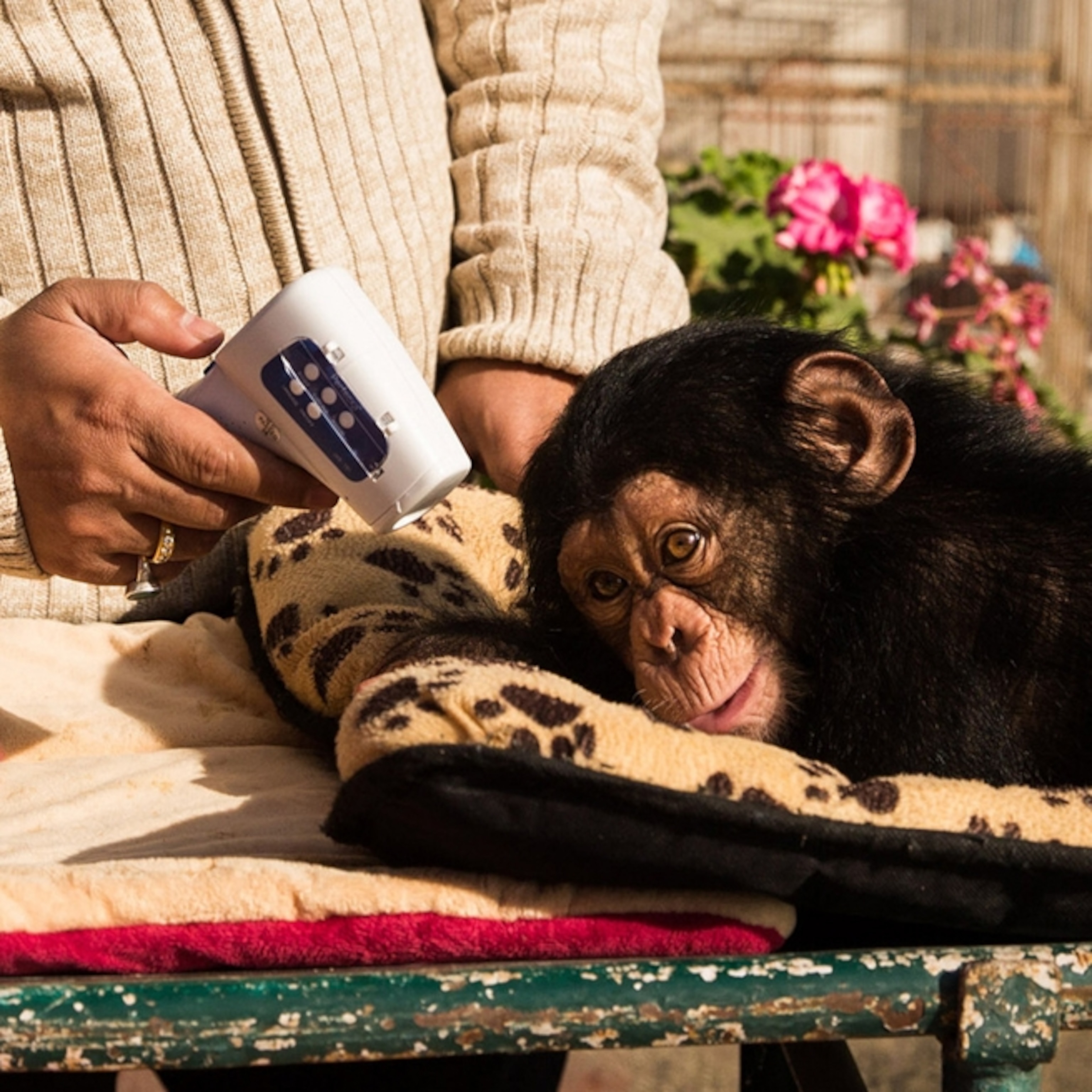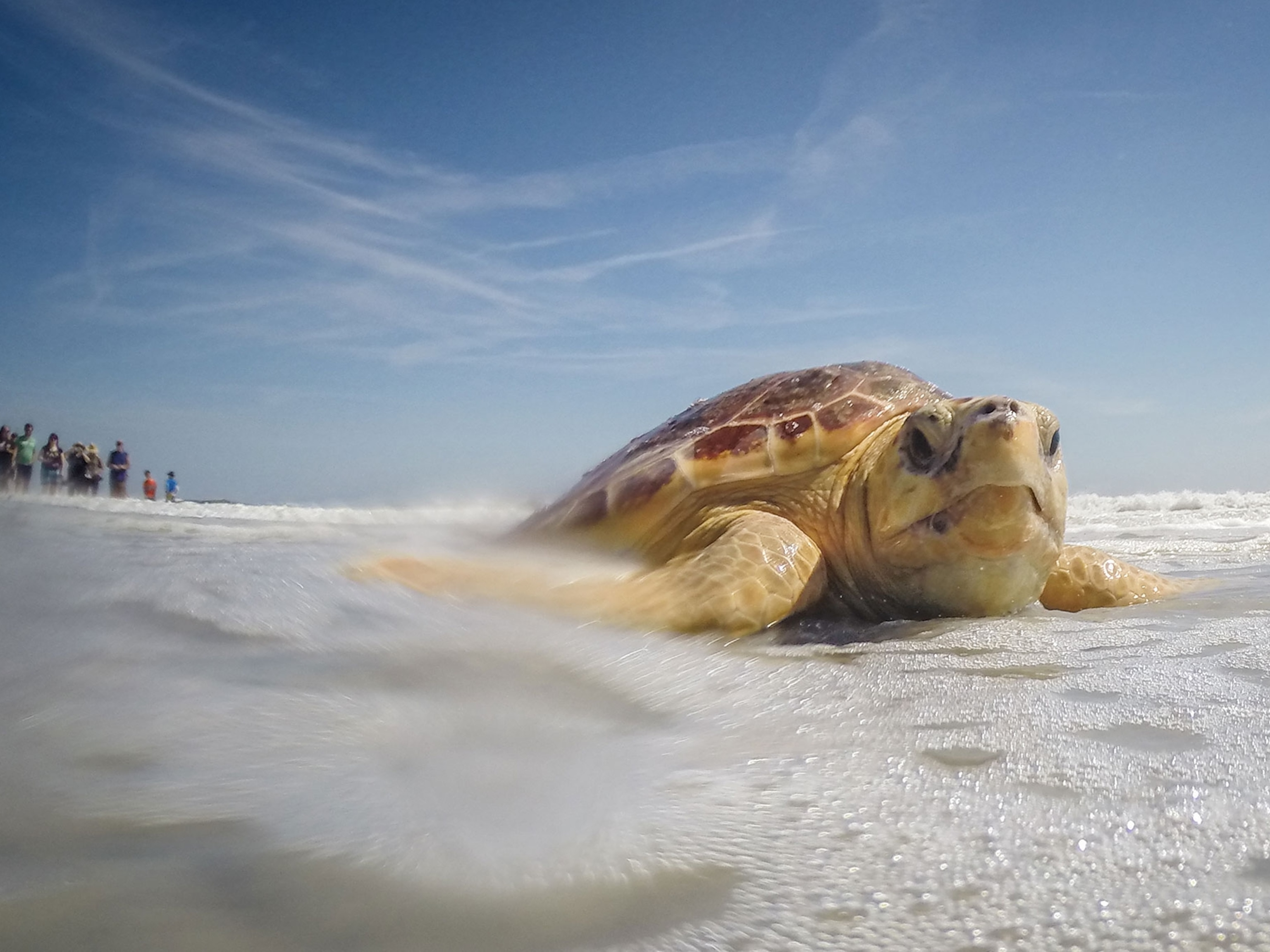
Sea cucumbers are being eaten to death
The marine animals are pricey status foods in China, fueling disastrous overfishing.
MOULAY ABDALLAH, MOROCCO — Two Moroccan divers stood on the rocks an hour before sunrise facing the gray Atlantic. Their wet suits were torn and patched, their flippers held together with tape. Unable to afford proper diving belts, the men wore thick bands of rubber strung with lead weights. Each carried a large black inner tube for floating out to sea.

It was low tide this June morning, and the water had drawn off the reef, exposing a carpet of green algae. The divers pulled on their flippers and slipped into the ocean, kicking until they were specks in the distance.
Both men were collecting seaweed out of season, which is illegal in Morocco but widely condoned by the government. They each stood to earn at most $60 that day, about a fifth of Morocco’s monthly minimum wage.
Ibrahim Morsli, 35, was also hunting illegally for sea cucumbers, an increasingly rare Chinese delicacy traded on the black market. The soft, knobbly creatures have fallen victim to a contagion of poaching that has spread, causing devastating declines, to most coastlines on Earth.

Sea cucumbers are nutrient factories, rich in protein and complex organic compounds. They have “a primordial ecological role,” said Hakima Zidane, a marine biologist at the National Fisheries Research Institute. “They’re like a purifying species for the ocean.”
Feeding on scraps of food, the creatures spend their lives inhaling salt water and expelling clear liquid and sediment. In many areas, their depletion has led to murkier or more polluted coastal waters. In coral reef habitats, where they buffer the effects of ocean acidification, their loss has made catastrophic bleaching events a graver threat.
Alarmed at Morocco’s declining stocks, the fishing ministry banned all sea cucumber exports in 2010 and began stepping up efforts to stop the illegal trade. But smuggling continues: Shortly before photographer William Daniels and I arrived in Casablanca, two Chinese men were caught at the airport with 220 pounds of dried sea cucumbers and fined $4,000 each.
Despite the risks, Morsli was proud of his hard work to support his family. “Put my real name in the story,” he insisted, soon after we met. His diving partner that day, more cautious, requested the pseudonym Omar. He avoided sea cucumbers, he said, explaining that if caught poaching them, he could spend six months in prison. (Under Moroccan law, sentences for illegal fishing range from three months to a year.) “When you get out of jail, it’s winter, and there’s no work for you,” he told me. “Without money, your family can die.”

Up before sunrise, in time for the muezzin’s first call to prayer, Morsli and Omar had gathered their equipment and walked to the beach. Their small fishing community, Moulay Abdallah, lies 60 miles southwest of Casablanca, and from its crowded gray apartments hundreds more townsfolk were also heading down to the sea.
A few would spend the day in wooden boats hoping to catch octopuses, lobsters, sardines, and other fish. Others would join Morsli and Omar on inner tubes offshore. Many more, including women and children, would wade in the shallows, scooping up seaweed—known locally as red gold—and the occasional sea cucumber.
Morsli and Omar were nearly a mile out when Daniels and I swam over to watch them work. They pointed at my thin diving vest and swimming trunks, mimed a shiver, and laughed. Morsli is film-star handsome, with strong cheekbones and a slender frame. Omar is brawnier, his heavy brows and coarse beard giving him the look of a street fighter (which he isn’t). Both men were wearing diving hoods—Morsli’s tangled locks were hidden, and Omar’s head appeared perfectly round. They reattached their masks and sucked air through their snorkels before submerging again.
Even this far from land, where the square minarets of the mosques stood in miniature, the water was just 20 feet deep. Red seaweed grew thickly on the bottom, drifting back and forth with the swell. The divers grabbed handfuls on each descent, stirring up clouds of sediment that drew scavenging fish. Here and there beneath the seaweed, fat and immobile like sausages, lay a more lucrative illicit catch.
Each time Morsli spotted a sea cucumber, he dropped it in a small pouch attached to his tube. After two hours, he’d collected fewer than 10. “This isn’t the region for sea cucumbers anymore,” he told me later. “It’s been overfished.”
“THESE WEIRD OBJECTS”
Sea cucumbers—there are some 1,700 species globally—are echinoderms, along with urchins and sea stars. Only a few species have sensory organs; none have brains, merely ganglia of nerves for coordinating movement. Essentially sedentary, the animals are easy to collect, particularly in shallow water. This leaves them vulnerable to overfishing for the black market.
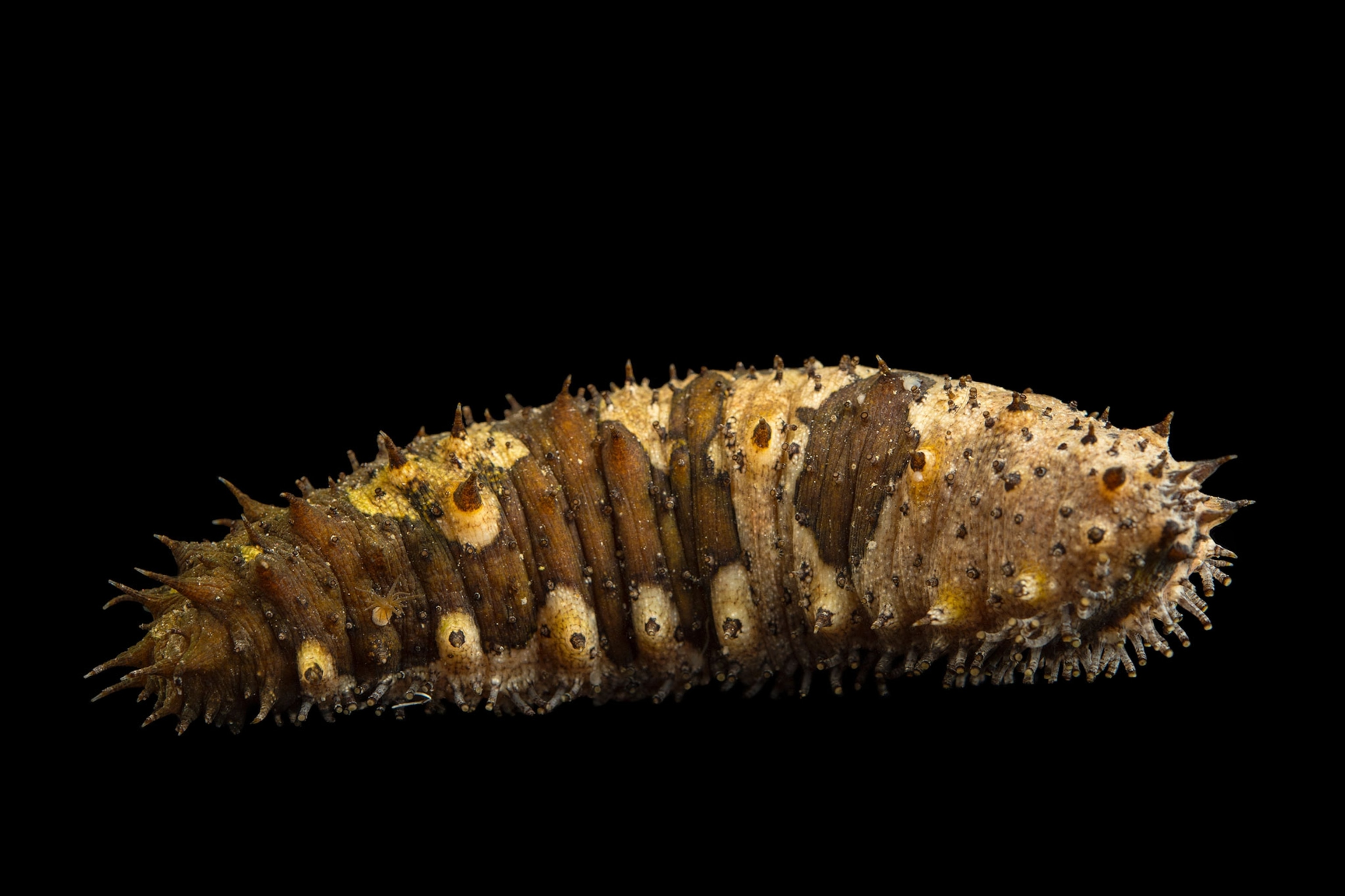


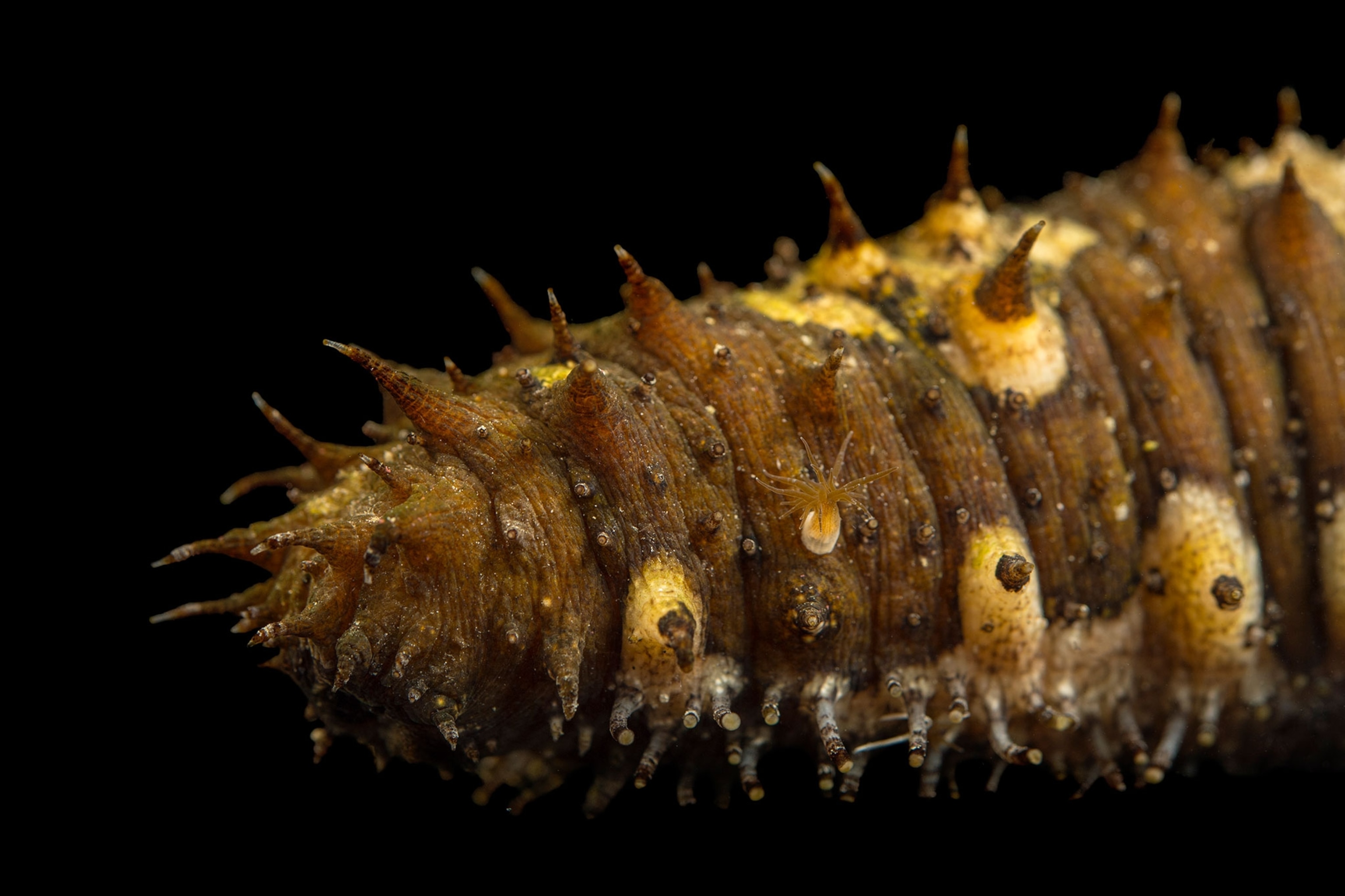



“I could not believe that these weird objects were alive,” the naturalist Gerald Durrell wrote of his first encounter with the animals. “I thought they must be strange, dead strands of some deep-sea seaweed now washed into the shallows by the tide, to roll and undulate helplessly.”
Some species crawl around on tubular feet; others burrow into the seafloor like worms. Many have the ability to slacken their body walls, allowing them to “pour” through narrow spaces or explosively self-eviscerate—a defense mechanism against predators—before regrowing their internal organs in a process scientists have studied for use in regenerative medicine. Stripping them from the oceans restricts opportunities to study them further, just as clearing rain forests destroys prospective medicinal plants.
The roughly 80 edible sea cucumbers are most common in tropical regions, often in the vicinity of poor communities such as Moulay Abdallah. With demand soaring in Asia, stocks are now depleted in a third of the more than 80 source countries. Scientists have listed 16 species as threatened, including those with the greatest commercial value. Another seven are listed as endangered. Of the five species identified in Morocco, three are edible and targeted by divers, according to Zidane, of the fisheries research institute.

For those who dive for sea cucumbers without proper gear or instruction, the hunt can be disastrous. In Moulay Abdallah alone, said Ahmed Dahbi, a former cucumber fisherman who now owns a café in the town’s business district, at least three fishermen have died, with many more injured.
“I became weak from diving until one day I collapsed,” said a friend of Dahbi’s named Ismail, who is rail thin and walks with a shuffle. “I was a broken man.” No longer able to dive, he said, he now cooks and dries sea cucumbers for a poaching syndicate.
Despite years of diving for sea cucumbers, Morsli and Omar told me they’d never eaten them. The animals simply weren’t food, they said—an opinion shared by all but one fisherman I met. Only Tibari Marini, a former diver from the village of Sidi Abed and now an activist advocating for fishermen’s rights, said he’d sampled his catch. A fisherman he knew had learned to prepare sea cucumber from an Asian buyer in Western Sahara.
“It was chewy and very rich,” Marini said, flushing with embarrassment. “After the meal, I got hot.”
“He means sexually excited,” my translator said.
“GINSENG OF THE SEA”
Dried and packaged in ornate boxes, sea cucumbers are a status food in Chinese cuisine, served to celebrate special occasions and honor guests. They’re popular not only in China but also throughout the diaspora: Singapore, Vietnam, and Chinatowns in the United States, among other hubs.
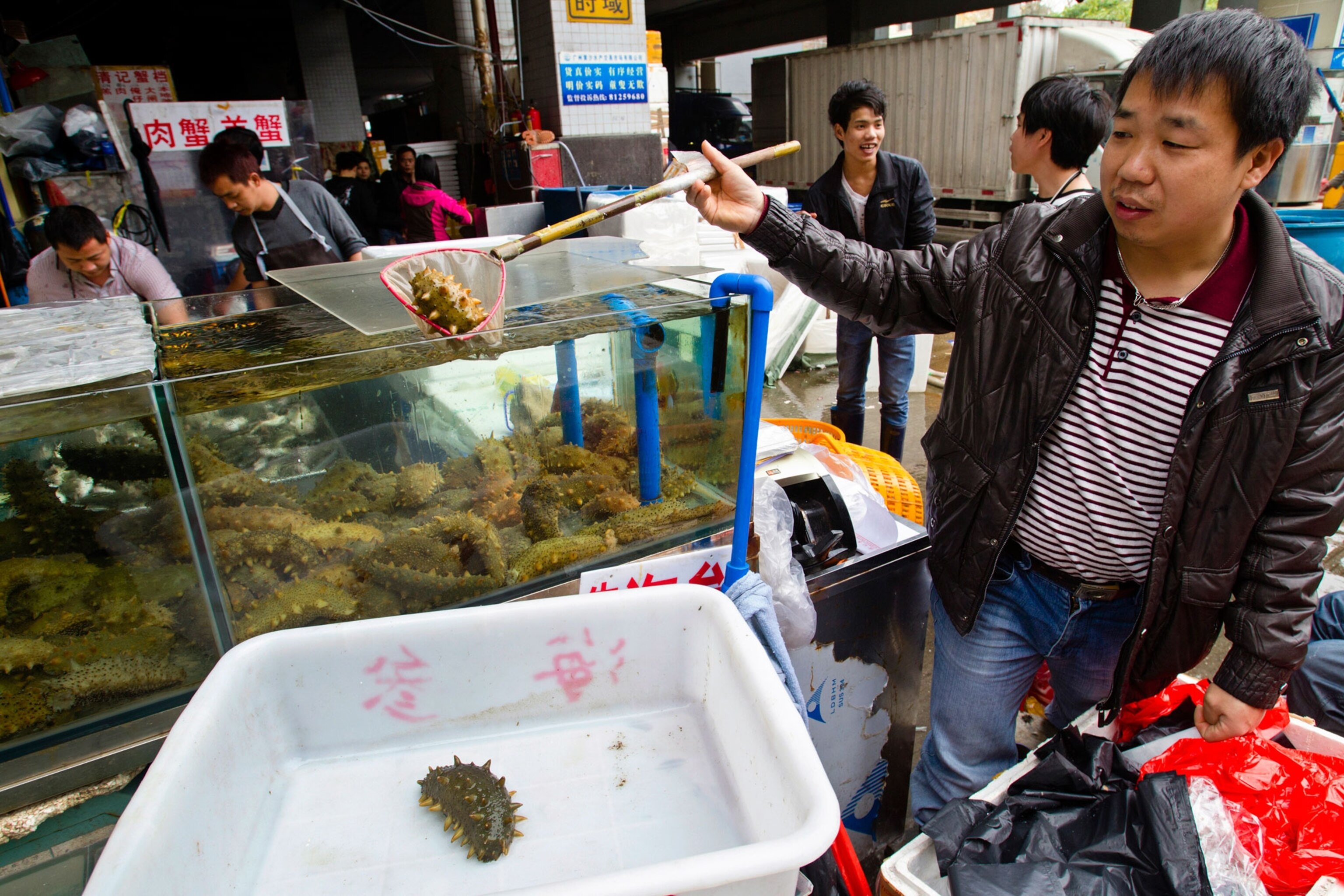
The soft-bodied creatures, which range in length from less than an inch to three feet and in color from dull brown to flamboyant red, have been popular in China since the Ming dynasty in the mid-1300s. Known as haishen—roughly “ginseng of the sea”—at first they were considered medicinal, their phallic resemblance thought to imbue them with power to combat impotence and fatigue. Later they came to be regarded as one of the four marine treasures of Cantonese cuisine, alongside shark’s fin, abalone, and the swim bladders of certain fish, such as the totoaba. A soup containing all four ingredients is known as “Buddha jumps over the wall” (its bouquet, the story goes, was enticing enough to tempt a vegetarian monk) and can cost more than $500 a serving.
When European nations sought silk, tea, and porcelain from China during the late 1700s, and the Chinese expressed little interest in receiving Western products in return, sea cucumbers became a bartering tool for international trade. European merchants began buying them up across Southeast Asia and the Pacific, along with other items coveted in China, such as birds’ nests (for soup), seaweed, and pearls.
Demand for sea cucumbers has boomed in recent decades, driven by the growth of China’s middle class. From 1996 to 2011, according to a 2015 study, the number of exporting countries jumped from 35 to 83.
“Globalised markets connect distant sources of supply with metropolitan areas of demand,” wrote Hampus Eriksson, the study’s lead author and a fisheries scientist with WorldFish, a nonprofit research group based in Malaysia. “Exploitation expands so fast across the world in these modern sourcing networks that overfishing can occur before the resource is even perceived as threatened.”

Eriksson’s team drew an analogy with epidemics, which are carried far and wide through shipping and air travel and then diffuse locally. “The speed and global connectivity of the global trade network” posed a growing threat worldwide, they warned, prompting a new term for the phenomenon: “contagious exploitation.”
By the early 2000s, traders along the East African coast were exporting thousands of tons of sea cucumbers annually. As stocks there declined, the focus swung to the waters of West Africa, including Morocco. In many source countries, the trajectory would be similar: a frenzied boom followed by depletion, with exports shifting onto the black market.
In 2001, authorities in the Seychelles arrested 110 fishermen for poaching sea cucumbers. In 2012, in a marine protected area in Madagascar, a patrol caught 80 divers with sea cucumbers, impounding 48 dive tanks and a speedboat.
Around the world, the trade fell under the control of “sea cucumber mafias,” said Marcel Kroese, of Traffic, the nonprofit organization that monitors wildlife smuggling. In Asia, Japan’s notorious Yakuza gangs muscled in on the market. Ivory traffickers in the southern Chinese town of Shuidong, exposed by an Environmental Investigations Agency undercover operation that was published in 2017, established their trade networks by importing sea cucumbers. In Mexico, rival poaching groups began warring, with at least one boat set alight and reports of gunfire at sea.
Sea cucumbers don’t earn local divers like Ibrahim Morsli much cash, but they can bring huge sums for traders at the top of the chain—and sometimes stiff penalties. In September, a Seattle, Washington, resident named Hoon Namkoong was fined $1.5 million for exceeding legal sea cucumber quotas and sentenced to two years in prison. Also in September, a man from San Diego, California, was fined almost a million dollars for illegally buying and selling sea cucumbers from Mexico.

The first official record of sea cucumber exports from Morocco, dating to 2001, is based on information from import records in Hong Kong, a major hub of China’s dried-seafood trade. According to Ahmed Dahbi, the café owner, that was the year Chinese buyers first arrived in Moulay Abdallah, asking for sea cucumbers.
The Moroccans were mystified. “We didn’t understand why the Chinese wanted [them],” Dahbi said. “We only learned later that they think it’s an aphrodisiac.”
In the early days, Dahbi explained, sea cucumbers rolled around in the shallows in such profusion it was difficult not to squash them underfoot. Wading close to shore, you could collect more than a thousand in a single morning.
The thriving, unregulated fishery brought a new stream of income for local people, but it wasn’t long before stocks plummeted in places like Moulah Abdallah and Sidi Abed. The boom has shifted to the disputed territory of Western Sahara, where, according to environmental activist Lahcen Dalil, poaching crews using high-powered speedboats may recover tons of sea cucumbers in just one night.
THE ABALONE CONNECTION
In 2005 Morocco’s sea cucumber industry got an unlikely boost from a group of abalone poachers from South Africa. (Abalone, fleshy marine snails, are also highly prized in Chinese cuisine.) One of the men, a Moroccan kickboxer who asked to be called Ali for his safety, had emigrated to Cape Town, becoming a henchman for a local protection racket. Another member of the group, a South African diver identified as Shuhood, had fished illegally for abalone for years.
By the early 2000s, according to Traffic, syndicates had smuggled more than 55,000 tons of abalone out of South Africa, decimating local stocks. The government was pushing back against poaching. Shuhood was out on bail for two poaching cases, and he knew he’d be sent to prison if caught again.

One morning before they went diving together, Ali mentioned to Shuhood that there were abalone beds in Morocco that no one had exploited. With no oversight, Ali said, it would be possible to “basically work legally.” (Only years later did the authorities begin regulating abalone fishing.)
Through Shuhood’s contacts, they arranged a meeting with Russel Jacobs, one of South Africa’s most powerful abalone smugglers. (Jacobs was connected to local drug cartels and Chinese mafia who control the illegal abalone industry in South Africa, according to police.) For a cut of the profits, Jacobs agreed to fly with the men to Casablanca and export their abalone to Hong Kong, Shuhood said.
As expected, the divers found abalone in Morocco, but the shellfish were too small to sell—at most the size of a walnut when dried. The trip seemed a failure until Shuhood spotted sea cucumbers on the reefs. He vaguely recalled from a nature documentary that the animals were also in great demand in China. So he brought some to the surface and told Jacobs, who texted his buyer in Hong Kong.
According to Shuhood, a message came right back: Send as many as you can.
By then the crew had reached Ouleedia, a small town 60 miles west of Moulay Abdallah. The seaweed divers there had never fished for sea cucumbers, Shuhood told me, but were eager for extra work. The South Africans offered them a little more than the going price for seaweed, and within a week, the divers had recovered more than a ton of cucumbers.
The South Africans cooked and dried the haul in a rented apartment, following instructions from Hong Kong. Ali prepared the first batch for export, declaring it as dried fruit. That shipment got through, but customs officials in Casablanca confiscated the next. Soon afterward, according to Shuhood, the men gave up and flew home to Cape Town, where they resumed poaching abalone.
Shuhood was arrested the following year and jailed for 18 months. In prison, he began writing about his poaching experiences. (When he and I met, more than a decade later, we began working on a book together.) Ali, the Moroccan, drifted into other forms of organized crime. Jacobs expanded his smuggling empire but was assassinated in 2017. His killers, thought to be linked to rival kingpins, remain at large.
In Ouleedia, meanwhile, the divers soon found new buyers for their sea cucumber catch. Today, Morsli said, the cucumbers of Ouleedia are “finished.”
REWARDS OF THE DAY
By the end of their day’s dive, Morsli and Omar had each bagged nearly 350 pounds of seaweed, bulging from giant nets beneath their tubes. Morsli also had 30 or so sea cucumbers, weighing about five pounds, in his pouch. After six hours in the water the men’s fingertips were swollen and wrinkled. It took them 45 minutes to kick their loads back to shore.

On the beach, blazing hot now that the morning clouds had burned off, Morsli’s wife and mother packed the seaweed into large sacks, lugging them up to a handcart at the road. The sea cucumbers, worth less than eight dollars, were quickly hidden away. Omar’s wife and mother were loading a cart of their own. Other divers up and down the coast were hauling sacks of seaweed away by donkey, balancing them on hessian saddles.
Both families headed for an unfinished housing project at the edge of Moulay Abdallah. They spread armfuls of seaweed out to dry on the road between vacant plots, and it soon looked as if the tarmac had sprouted red fur. Omar’s mother, in her 70s, worked barefoot despite the heat, sweating as she moved back and forth from the cart. “We work until we die,” she said with a weary laugh.
Afterward, Daniels and I visited Omar at home, a narrow, two-story building of bare concrete bricks. In a small downstairs room, hidden behind a curtain, he showed us a giant mound of dried seaweed. As soon as the legal seaweed season opened, in July, Omar said, he would sell the stockpile to a middleman supplying Morocco’s biggest seaweed factory. He expected to earn about $530. Normally that would be enough to feed his family for nearly two months, but there were water and electricity bills to pay, as well as a debt of more than $120 to the grocer. Omar’s young sons needed new clothes, and his parents needed diabetes medication. “The money flies,” Omar said, pressing his fingers to his brow.
His seaweed would be processed into agar, an inert, flavorless gel used for growing microbial cultures and in a range of industries, including food processing and cosmetics. Until recently, Morocco was the world’s biggest supplier, with annual harvests exceeding 15,000 tons. In 2010, however, with seaweed becoming scarcer, the government reduced legal quotas and restricted exports, leading to global shortages.

Morsli’s house, just around the corner, was smaller than Omar’s but better equipped, with a washing machine, a large bedroom wardrobe, and thick rugs on the floors. By the time we arrived, the sea cucumbers that would minimally boost his income had vanished into a fridge, where they’d remain until his buyer called.
Though “difficult and dangerous,” collecting cucumbers was worth the risk, Morsli said. To support his family, he needed every dollar he could get. “The situation in Morocco is like this,” he explained, tousling the hair of his son and daughter, who are nine and four. “If you want to protect the sea, you won’t live. And if you want to live, you have to exploit the sea.”
“A VERY IMPORTANT COMMERCIAL OPPORTUNITY”
Hakima Zidane is the official in charge of determining a sustainable level of sea cucumber exploitation in Morocco. Sea cucumbers are considered a “very important commercial opportunity,” she told me, and the government is planning to grow the industry. “Our work is to promote balanced exploitation.”
This is not a straightforward task. By 2012, when stock assessments began, sea cucumbers had already reached an advanced stage of depletion, according to Zidane and more than a dozen fishermen I spoke with. Illegal fishing, meanwhile, has made it difficult to establish baseline data for setting quotas.

Last year, the fisheries department established a sea cucumber management plan that includes a trial harvesting program. The fishery is organized into five coastal regions, each with its own catch limits. The total quota came to just under 500 tons the first year.
Under the plan, fishing may take place only from sunrise to sunset, and diving from boats or with any kind of breathing apparatus is forbidden. Strict rules govern who may buy, process, and export the catch. These regulations are intended to “ensure the rational exploitation of sea cucumbers,” notes a government document published last year.
Yet the illegal fishing goes on. In the corridors of a national fisheries building in Casablanca, an officer responsible for marine patrols explained the difficulty of enforcing the law. Because he didn’t have formal permission to speak to me—Morocco is an authoritarian state—he insisted on anonymity.
“When you see the situation of the fishermen and their families, you know it would be much worse if they end up in jail,” he said. Recently, he’d tried to confiscate fish being sold illegally at a crowded outdoor market in Casablanca, and the trader had come at him with a knife. Another time, a sea cucumber fisherman he’d caught on the water had poured gasoline on himself—just like the Tunisian fruit vendor who triggered the Arab Spring in 2010—and threatened to set himself on fire.
“People are poor, and people are angry,” the officer said. “You have to know when to look the other way. You can’t always push too hard.”
In a small cove near Sidi Abed one afternoon, Daniels and I came upon dozens of villagers collecting seaweed. Children ran barefoot along a shoreline of jagged rocks. In the shallows, women in hijabs and long dresses ducked underwater to grab clumps of seaweed, stuffing it in their hitched-up skirts. Farther out, young men dived in cycles that seemed endless, pulling up as much seaweed as they could. We watched as, a few yards from shore, a boy no older than 12 scooped up a small sea cucumber. Cupping it gently, he walked over to his mother and handed it to her, before turning once more to the sea.
Kimon de Greef is a journalist based in Cape Town, South Africa. He has written for National Geographic, the New York Times, and the Guardian. His first book, Poacher: Confessions From the Abalone Underworld, co-authored with former abalone poacher Shuhood Abader, was published in September. Follow him on Twitter.
Related Topics
You May Also Like
Go Further
Animals
- This ‘saber-toothed’ salmon wasn’t quite what we thoughtThis ‘saber-toothed’ salmon wasn’t quite what we thought
- Why this rhino-zebra friendship makes perfect senseWhy this rhino-zebra friendship makes perfect sense
- When did bioluminescence evolve? It’s older than we thought.When did bioluminescence evolve? It’s older than we thought.
- Soy, skim … spider. Are any of these technically milk?Soy, skim … spider. Are any of these technically milk?
- This pristine piece of the Amazon shows nature’s resilienceThis pristine piece of the Amazon shows nature’s resilience
Environment
- This pristine piece of the Amazon shows nature’s resilienceThis pristine piece of the Amazon shows nature’s resilience
- Listen to 30 years of climate change transformed into haunting musicListen to 30 years of climate change transformed into haunting music
- This ancient society tried to stop El Niño—with child sacrificeThis ancient society tried to stop El Niño—with child sacrifice
- U.S. plans to clean its drinking water. What does that mean?U.S. plans to clean its drinking water. What does that mean?
History & Culture
- Séances at the White House? Why these first ladies turned to the occultSéances at the White House? Why these first ladies turned to the occult
- Gambling is everywhere now. When is that a problem?Gambling is everywhere now. When is that a problem?
- Beauty is pain—at least it was in 17th-century SpainBeauty is pain—at least it was in 17th-century Spain
- The real spies who inspired ‘The Ministry of Ungentlemanly Warfare’The real spies who inspired ‘The Ministry of Ungentlemanly Warfare’
- Heard of Zoroastrianism? The religion still has fervent followersHeard of Zoroastrianism? The religion still has fervent followers
Science
- Here's how astronomers found one of the rarest phenomenons in spaceHere's how astronomers found one of the rarest phenomenons in space
- Not an extrovert or introvert? There’s a word for that.Not an extrovert or introvert? There’s a word for that.
- NASA has a plan to clean up space junk—but is going green enough?NASA has a plan to clean up space junk—but is going green enough?
- Soy, skim … spider. Are any of these technically milk?Soy, skim … spider. Are any of these technically milk?
- Can aspirin help protect against colorectal cancers?Can aspirin help protect against colorectal cancers?
Travel
- What it's like to hike the Camino del Mayab in MexicoWhat it's like to hike the Camino del Mayab in Mexico
- Is this small English town Yorkshire's culinary capital?Is this small English town Yorkshire's culinary capital?
- Follow in the footsteps of Robin Hood in Sherwood ForestFollow in the footsteps of Robin Hood in Sherwood Forest
- This chef is taking Indian cuisine in a bold new directionThis chef is taking Indian cuisine in a bold new direction


